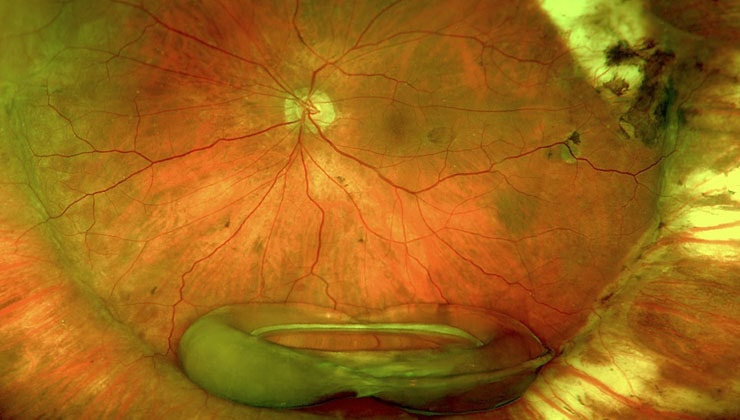
What is intraocular lens dislocation?
Intraocular lens (IOL) dislocation is a very rare condition that affects patients who have undergone cataract surgery and consists of the displacement of the implanted lens towards the vitreous cavity of the eye. On other occasions, the lens becomes decentred from the visual axis but does not fall into the vitreous cavity (subluxation).
Displacement of the intraocular lens causes changes to vision and, if it falls into the vitreous cavity, it can produce traction due to the eye’s own movement, resulting in retinal detachment and/or vitreous haemorrhage.
What causes it?
It is estimated that between 0.05% and 3% of patients who have undergone cataract surgery will suffer from a spontaneous dislocation of the IOL. Some studies show that its incidence is higher 5 years after surgery.
Sufferers usually have the following disorders or previous procedures:
- Crystalline pseudoexfoliation syndrome (PSX), which consists of breakage of the fibres of the ligaments that support the natural lens of the eye (zonule).
- High myopia
- Previously performed surgical procedures, such as glaucoma and vitrectomy
- Eye injuries
How can it be prevented?
IOL dislocation cannot be prevented as it occurs spontaneously. It is important, however, for patients who have undergone cataract surgery to have regular check-ups and urgently visit the ophthalmologist if they notice any loss of vision.
Symptoms
The most characteristic symptom of IOL dislocation is loss of vision, although some patients also complain of blurred or unfocused vision. It does not cause pain.
Associated treatments
If the lens is in the vitreous cavity, treatment consists of performing a vitrectomy in order to remove it and implant another or reposition it. In cases where the IOL has not fallen into the vitreous cavity, the surgeon can simply reposition it without the need to perform a vitrectomy.
Specialists who treat this pathology
FAQs
Angiography is a technique used to delineate retinal or choroidal cases. Different contrasts are used, usually sodium fluorescein or indocyanine green. The scan is also useful for the diagnosis of other retinal diseases, such as pigment epithelium. In general, angiography is used to study many retinal diseases and their diagnosis.
Indocyanine green angiography is a technique used in some cases of AMD and serves to define the neovessels and, occasionally, to diagnose other diseases. Fluorescein angiography is the standard technique for studying blood vessel diseases and the retina in general.
It is a diagnostic technique to determine pathological and abnormal structures in the blood vessels and the different layers of the retina. It can be used in cases of macular degeneration, diabetic retinopathy, vasculopathy and many other macular disorders.
It is not counterproductive for any eye treatment.
If a patient who has been operated on for cataracts or other intraocular processes suffers a severe loss of vision with noticeable eye redness and pain, he or she must go and see an ophthalmologist urgently and without delay, as the emergency could threaten the vision of the eye.
IMO Institute of Ocular Microsurgery
Josep María Lladó, 3
08035 Barcelona
Phone: (+34) 934 000 700
E-mail: international@imo.es
See map on Google Maps
By car
GPS navigator coordinates:
41º 24’ 38” N – 02º 07’ 29” E
Exit 7 of the Ronda de Dalt (mountain side). The clinic has a car park with more than 200 parking spaces.
By bus
Autobus H2: Rotonda de Bellesguard, parada 1540
Autobus 196: Josep Maria Lladó-Bellesguard, parada 3191
Autobuses H2, 123, 196: Ronda de Dalt – Bellesguard, parada 0071
How to arrive at IMO from:
IMO Madrid
C/ Valle de Pinares Llanos, 3
28035 Madrid
Phone: (+34) 910 783 783
See map in Google Maps
Public transport
Metro Lacoma (líne 7)
Autobuses:
- Lines 49 & 64, stop “Senda del Infante”
- Line N21, stop “Metro Lacoma”
Timetables
Patient care:
Monday to Friday, 8 a.m. to 9 p.m.
IMO Andorra
Av. de les Nacions Unides, 17
AD700 Escaldes-Engordany, Andorra
Phone: (+376) 688 55 44
See map in Google Maps
IMO Manresa
C/ Carrasco i Formiguera, 33 (Baixos)
08242 – Manresa
Tel: (+34) 938 749 160
See map in Google Maps
Public transport
FGC. Line R5 & R50 direction Manresa. Station/Stop: Baixador de Manresa
Timetables
Monday to Friday, 09:00 A.M – 07:00 PM














